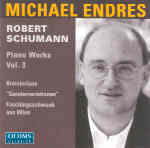Even in a market saturated with first-rate recordings of Schumann’s Kreisleriana, Michael Endres manages to leave an individual imprint by way of several unusual interpretive gambits. In contrast to the surges of energy pianists like Horowitz and Argerich bring to No. 1’s outer sections, Endres’ lower-voltage virtuosity makes varied voicings and balances between hands his number one priority. The pianist’s drawn out bass lines and juicy pedaling in No. 2 are quite seductive, but his tempos for the two intermezzos separating the main sections move slower than the molto vivace and poco più mosso Schumann requests. Likewise, No. 3’s tempos do not sufficiently contrast, but I like how Endres takes care to make the left-hand staccatos and accented notes distinct–no easy task!
No. 5 begins as light, playful, and contrapuntally astute as possible. As the piece progresses, the pianist’s de-synchronized octaves and distensions of phrase begin to wear thin. Endres’ headlong sprint through No. 7 leaves little room for Schumann’s “nach schneller” (faster still) to truly register, although as the movement winds down, the pianist’s ghostly pedal effects make for an apt transition into the spooky No. 8.
Given his constant hunt for subsidiary voices throughout Kreisleriana, it’s odd how Endres mostly subdues the E-flat Variations’ inner lines and keeps all urgency in check until the final movement. In Faschingsschwank aus Wien I empathize with Endres’ desire to manipulate articulation and voicing in order to make No. 1 less repetitious, but he overdoes it, and the resultant hesitations before key downbeats sound contrived and mannered, as do No. 3’s clipped bass lines. However, the gorgeous Intermezzo (No. 4) sparkles by way of Endres’ agitated drive. The finale continues along similar lines, fortified by the pianist’s wide dynamic range and motoric momentum (notwithstanding louder moments veering on percussiveness). Not all aspects of Michael Endres’ Schumann will suit every taste, but its most compelling moments stay with you.
































